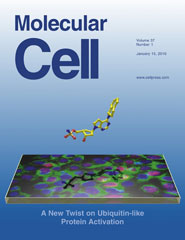
法国国家科研中心日前表示,它与意大利和德国的科研机构合作,发现了细菌能够在低温环境下存活的秘密。
细菌具有强大的环境适应能力,能够在低温条件下存活。此前有研究发现,一种名为“冷休克蛋白”的蛋白质是细菌低温存活的关键,但它发挥作用的机制一直是个谜。
法国国家科研中心、意大利卡梅里诺大学和德国杜塞尔多夫大学组成的联合研究小组发现,“冷休克蛋白”的信使核糖核酸具有感知冷暖的特殊能力,这是科学界首次发现信使核糖核酸具有这种能力。
信使核糖核酸的主要功能是复制生物的遗传信息。感知温度的特殊功能使“冷休克蛋白”的信使核糖核酸只有在低温的情况下才会表现稳定。也就是说,在低温下,信使核糖核酸反而能够更有效地复制细菌的遗传信息,帮助细菌生存繁衍。
研究人员表示,该研究成果将为抑制细菌生长提供新思路。有关成果刊登在最新一期的美国《分子细胞》杂志上。
生物谷推荐原始出处:
Molecular Cell, Volume 37, Issue 1, 21-33, 15 January 2010
The cspA mRNA Is a Thermosensor that Modulates Translation of the Cold-Shock Protein CspA
Anna Maria Giuliodori, Fabio Di Pietro, Stefano Marzi, Benoit Masquida, Rolf Wagner, Pascale Romby, Claudio O. Gualerzi, Cynthia L. Pon
Cold induction of cspA, the paradigm Escherichia coli cold-shock gene, is mainly subject to posttranscriptional control, partly promoted by cis-acting elements of its transcript, whose secondary structure at 37°C and at cold-shock temperature has been elucidated here by enzymatic and chemical probing. The structures, which were also validated by mutagenesis, demonstrate that cspA mRNA undergoes a temperature-dependent structural rearrangement, likely resulting from stabilization in the cold of an otherwise thermodynamically unstable folding intermediate. At low temperature, the “cold-shock” structure is more efficiently translated and somewhat less susceptible to degradation than the 37°C structure. Overall, our data shed light on a molecular mechanism at the basis of the cold-shock response, indicating that cspA mRNA is able to sense temperature downshifts, adopting functionally distinct structures at different temperatures, even without the aid of trans-acting factors. Unlike with other previously studied RNA thermometers, these structural rearrangements do not result from melting of hairpin structures.







